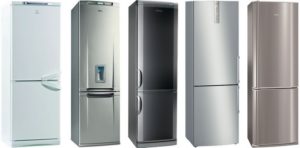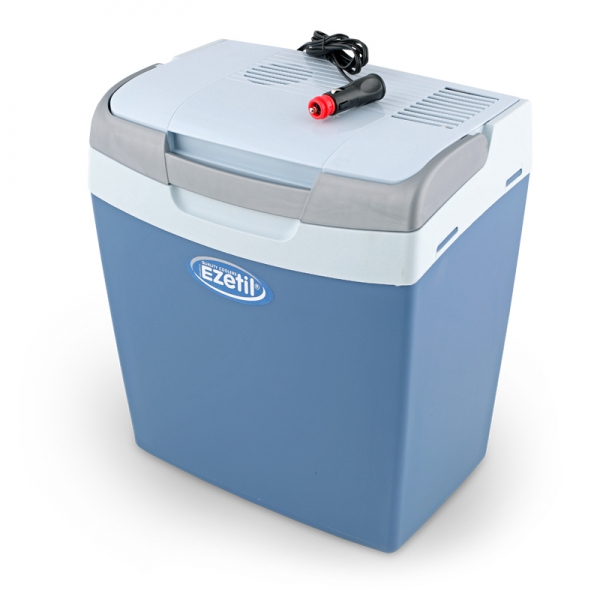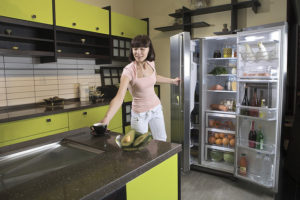 A person who, for the first time, goes beyond the scope of standard household appliances familiar from childhood, is often surprised to learn that there are different types of refrigerators. They differ not so much in the principle of action, which consists in the removal of heat from products in the storage chamber, as in the technologies that are used for this.
A person who, for the first time, goes beyond the scope of standard household appliances familiar from childhood, is often surprised to learn that there are different types of refrigerators. They differ not so much in the principle of action, which consists in the removal of heat from products in the storage chamber, as in the technologies that are used for this.
Content
Compressor class
The most common type of refrigerator is the compressor type. These are familiar household appliances that are in every apartment. A working fluid is used here - a refrigerant that removes heat from the interior of the storage chamber. In this case, the physical property of the gas is used - it is sharply cooled during expansion and heated during compression.
The technical solution of the compressor refrigerator includes:
- refrigerant, gas, capable of easily changing its state of aggregation;
- closed type compressor unit;
- a condensing system acting as a device for transferring heat to the environment;
- an evaporator where expansion and cooling of the working fluid takes place.
If you consider the design of the refrigerator by the location of the nodes, you can easily identify certain parts of the device. The compressor is located below, it is noticeable and recognizable. In the fridge may be one or two compressors. Capacitor - dark grille, occasionally manufacturers make a closed panel fixed to the back. It is enough to bring a hand to this area of the refrigeration unit to understand how much it heats up during operation to transfer heat.
The evaporator is inside the refrigerator. The structure of the tubes is hidden in the walls of the device, while each chamber (if we are talking about a model with divided spaces) has its own refrigerant expansion unit.
Immediately worth stopping on the methodology of multi-chamber single-compressor refrigerators. Different modes of cold are achieved by a simple redistribution of the refrigerant. A special electronically controlled gateway directs a certain amount of gas to the desired zone. However, under heavy load the refrigerator often cannot guarantee the exact observance of the given parameters of the internal climate of the chambers.
Two-compressor refrigerators look great. They are specially designed to guarantee extremely high values of cold removal in freezers and medium - in food storage areas with temperatures above zero or within -10 degrees Celsius.
The scheme of the compression system simple:
- The refrigerant is fed to the evaporator, where it suddenly changes from a liquid to a gaseous state. The temperature drops dramatically, heat is removed from the storage room.
- Passing the evaporator tubes, the heated gas enters the compressor.
- At high pressure, refrigerant enters the condenser. The compressed gas is very hot, while passing through a long tube it gradually cools.
- At the outlet of the condenser, the gas has a temperature that allows it to go into a liquid state. Refrigerant is collected in a capillary device.
Further the circuit repeats. The liquid enters the evaporator, passes into a gaseous state, while cooling very much. The cycle is duplicated again and again. Until the temperature sensors inside the refrigerator compartment give a stop signal to the compressor.
Modern superchargers of refrigerators are made in a closed circuit. All structural parts of the compressor are located in a sealed volume. This avoids refrigerant leaks, and the use of special refrigeration oils guarantees long years of operation of the supercharger.
Today, Freon-12 is used as the refrigerant.This gas is not the best option, since its boiling point is relatively high, about -30 degrees. In the years of the USSR, there was another option - refrigerators with nitrogen refrigerant. He could provide a sharp selection of heat up to -98 degrees Celsius. However, unlike freon, such a refrigerant was potentially dangerous in the event of a compressor unit accident, and could be harmful to human health, so they refused to use it.
Absorption Refrigerators
Absorption - this is not very familiar to the average user installation. These types of refrigerators are well known to those who are used to living in areas without electricity, and this type of device is also widely used by truckers.
The refrigerant in the absorption scheme is a concentrated ammonia solution. The refrigerator operates as follows:
- in the separation zone, the concentrated solution is heated, ammonia evaporates;
- gas is supplied to the evaporator, where it expands and removes heat from the food storage chamber;
- at the same time, the remainder of the solution is pumped into the absorption chamber;
- after the passage of the evaporator, the temperature of ammonia rises, it is fed into the absorption chamber, where it mixes with its own weak solution, increasing its concentration. The mixing zone is cooled by fans or (depending on the energy source) naturally.
The composition obtained at the end of one cycle is again pumped into the heating chamber. The refrigerator repeats the ammonia circulation pattern until the set temperature inside the food storage chamber is reached.
An absorption refrigerator has a lot of disadvantages that sharply limit its widespread use in everyday life. Firstly, a concentrated solution of ammonia is very dangerous, in the event of an accident and leakage, health damage can be expressed in the number of dead people who were in the immediate vicinity of the device. Manufacturers are aware of this, therefore, multi-stage protection is applied to prevent evaporation into open air. Secondly, the performance of the absorption unit is small. Refrigerators freeze slowly and are easily put into continuous operation, overload, just forgetting to close the door. Low rates of heat dissipation also prevent large storage chambers or freezing.

But absorption refrigerators have advantages. As a heat source can be used:
- electricity, heating shades;
- natural combustible gas, which makes the absorption refrigerator an excellent option for giving far out of town;
- exhaust gases of an internal combustion engine, which are characterized by some models for truckers.
A modern absorption-type refrigerator is a product quite widespread on the market, reliable, convenient, designed for a clearly defined target segment of the audience. This is not to say that, according to the principle of operation, this class is very different from the compressor class. They are similar, but each of them has radically different applications.
Thermoelectric installations
Thermoelectric refrigerators are called direct heat absorption units. There is no refrigerant, circulation system, transition of aggregate states and other difficulties. The cooler is a semiconductor plate. The thermoelectric installation uses the Peltier effect and works as follows:
- when an electric current of a certain polarity is applied, the plate cools;
- heat is taken from the food storage chamber;
- when a voltage of reverse polarity is applied, the temperature of the semiconductor increases, so the thermoelectric installation can heat the contents.
From the principle of operation follows a group of restrictions that is inherent in all refrigerators of direct heat conversion. The list looks like this:
- the current drawn by the device is limited to prevent overloading the power source. Therefore, there is the concept of temperature delta. In simple words - the number of degrees of difference between the environment and the space of the left-luggage office. For example, if the refrigerator provides a decrease of 30, then with a forty-degree heat, drinks and food will be cooled to 10 heat;
- there is an indicator of the lowest possible temperature below which the semiconductor wafer cannot cool. For expensive models of thermoelectric refrigerators, the value of this characteristic is in the range from -6 to -3 degrees Celsius;
- thermoelectric plant removes heat extremely slowly. Therefore, before placing inside the chamber, the products must be cooled. Otherwise, it will take an extremely long time to wait for a comfortable temperature for drinks or meat.
The above restrictions do not prevent thermoelectric refrigerators from being extremely popular with motorists, lovers of travel and outdoor recreation. Ice can be added to the chamber to facilitate the installation task, there are models for sale with a variety of chamber volumes - from a small storage for drinks to several tens of liters.

Section for the Humanities
Recalling the funny phrase “when I asked what phone, I had to say red or blue, and not pour in numbers and unfamiliar frightening words”, we give another classification of refrigerators, which also choose shopping in stores. Modern devices can be:
- desktop - this is a small format that is very convenient for cooling drinks or storing small-volume products;
- wall mounted in the form of hanging cabinets of different sizes. Such a refrigerator is convenient to integrate into the composition of the kitchen set;
- floor standing is the most popular format familiar to every modern person. One, two, three-chamber, with a different number of doors, equipped with retractable storage chambers, with one or two compressors - this class of refrigerators is carried out in an incredible number of versions;
- Built-in - a rarely sold and quite unpopular class. Its inconvenience is that the installation requires an influx of fresh air to cool the condenser or other heat removal unit. And to do this on condition of installing the installation in furniture or a wall niche is quite problematic.
Today, the market offers everything a potential refrigerator owner needs to meet their needs. There are models of different sizes, built on one or another principle, convenient in certain areas of application.
In conclusion
Concluding the review of technologies for creating cold, one cannot but mention vortex installations. It is large and with large power indicator industrial monsters in which simple air acts as a coolant. It is supplied by compressors under tremendous pressure (20-30 atmospheres) to special zones of vortex scattering, where a sharp drop in temperature occurs. Acceptable performance is only achieved with a truly huge installation scale. Therefore, vortex refrigerators are used almost exclusively in industry for cooling, for example, water in drip plants.



the article is interesting. When I took my indesit, I didn’t think at all. I chose it because I trust the manufacturer. Well, now, after reading the article, I’ll at least understand a little what and how.